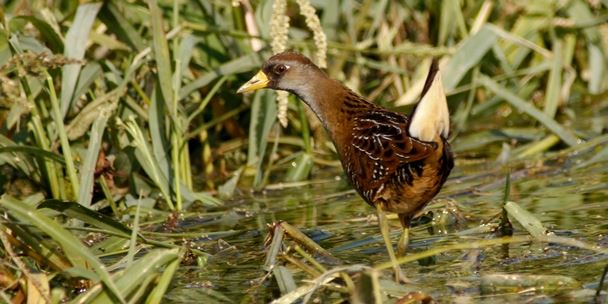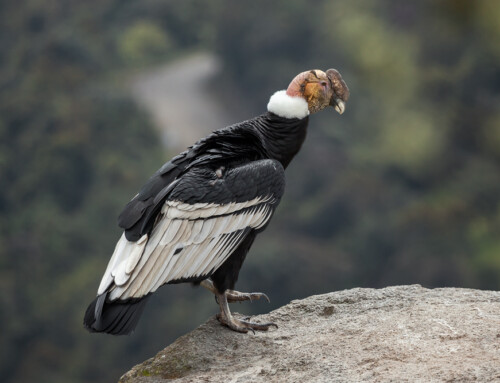How does the migratory connectivity of secretive species differ?
LINKED PAPER
Using citizen science monitoring data in species distribution models to inform isotopic assignment of migratory connectivity in wetland birds. Fournier, A.M.V., Drake, K.L. & Tozer, D.C. 2017. Journal of Avian Biology. DOI: 10.1111/jav.01273. VIEW
If you hear me talk about rails for any length of time you’ll soon hear me talk about how difficult they are to detect, and how little we know about them. Low detection, that is the low chance of actually seeing a bird when it is around, causes a lot of issues, one of which is its difficult to study their migration.
Not understanding a bird’s migration limits our ability to understand their population status (how their population is doing) since we don’t know the connections between different parts of their annual cycle. There are many methods of trying to better understand migratory connectivity, but few are appropriate for rails. Satellite transmitters are too heavy. Rails don’t have site fidelity so geolocators don’t work. Rails aren’t recaptured frequently enough or captured across a wide enough area for bird banding to be helpful. So that leaves us, until battery technology improves and makes lighter transmitters, with stable isotopes.
Stable isotopes, in this case hydrogen, are useful for tracking bird migration because the ratio of heavy to light hydrogen varies roughly from south eastern North America to north west North America. When a bird molts a feather, the hydrogen isotope ratio of the place it is living is preserved in that feather. Since feathers are inert material, we can capture the rail later in the year, pull the feather (causing no harm to the bird) and use that ratio to understand their migration.
We captured birds from Missouri and several other states during autumn migration and used stable isotopes to understand where they spent the previous breeding season (Fig. 1).

In this case we have used marshbird monitoring program citizen science data from the US and Canada to create a species distribution model. The species distribution model allows us to show that the birds are not equally spread out over space, and thus improve our estimates. We used marshbird monitoring program data, because it has been collected in such a way that maximizes the chances of seeing or hearing a bird if one is present, so we get more informative models this way.
Figure 2 shows the cumulative assignment, that is the place where each individual bird is assigned, added together, for each of the species. It’s important to note that we have drastically different sample sizes for the 3 species, and so they need to be interpreted different.
Sora, Porzana carolina, have a decent sample size (91 individuals) and are showing that birds which migrate through Missouri in the autumn are most likely coming from the middle part of North American, including the prairie potholes, in the northern US and southern Canada. Virginia Rail, Rallus limicola, and Yellow Rail, Coturnicops noveboracensis, which have much lower sample sizes, have different patterns. Yellow Rails were assigned to the upper great lakes region and northern Manitoba, Ontario and Quebec, barely overlapping with Sora, while Virginia Rail are split, with two individuals coming from central southern Canada and two coming from straight west of Missouri.
There are a few interesting things here. Yellow Rail and Sora, while they overlap during migration, are not strongly overlapping during the breeding season. Virginia Rail are also showing us an unexpected pattern, or at least it would be unexpected if I hadn’t seen a similar result in my previous work on Virginia Rails (Fournier et al. 2017b). At present, this suggests that something different is going on with Virginia Rails, it could one (or a combination) of a few things. From Virginia Rails have a different molt strategy then we think they do, to them migrating in a very different way then we expect, to their diet contributing to their feather hydrogen isotope values in an unexpected way. Future work, using different tools will be needed to tease apart this puzzle.

This is certainly not closing the door on migratory connectivity for rails, really it is just pushing it open a tiny bit and hoping that in the future we can open it even more. It does raise some interesting questions though, and this rail researcher is excited to see where those questions take us.
Huge thanks to Bird Studies Canada, including my two co-authors Doug Tozer and Kiel Drake, who made this paper, and the marshbird monitoring program data it used, possible and available.
References
Fournier, A.M.V., Drake, K.L. & Tozer, D.C. 2017. Using citizen science monitoring data in species distribution models to inform isotopic assignment of migratory connectivity in wetland birds. Journal of Avian Biology. DOI: 10.1111/jav.01273. VIEW
Fournier, A.M.V, Sullivan, A., Bump, J., Perkins, M., Shieldcastle, M.C. & King, S. 2017b. Combining citizen science species distribution models and stable isotopes reveals migratory connectivity in the secretive Virginia rail. Journal of Applied Ecology 54: 618-627. VIEW
Image credit
Featured image: Sora, Porzana carolina © Auriel Fournier
If you want to write about your research in #theBOUblog, then please see here.





